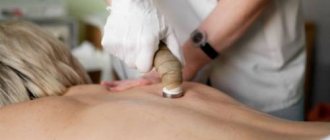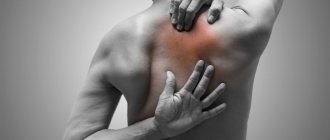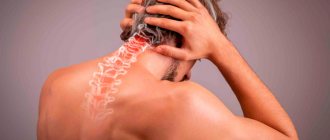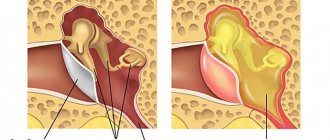12 April 2021
64578
0
2.9 out of 5
Although pain between the shoulder blades is not very common, for those who experience it, this is small consolation. At the same time, discomfort in the area between the shoulder blades can be a sign of a fairly large number of different diseases, some of which can lead to very serious complications and significantly reduce a person’s quality of life. Moreover, if pain in the neck or lower back can be a consequence of banal muscle fatigue after hard physical work, then pain between the shoulder blades due to low mobility of the thoracic spine cannot be of such a harmless nature. Therefore, their appearance should always be regarded as an alarming symptom and immediately contact a vertebrologist, neurologist or spinal surgeon.
Pain between the shoulder blades
One of the most common complaints when visiting a doctor is back pain.
However, it is the pain in the interscapular region that most people often ignore, since it is rarely very strong, due to the lack of mobility of the thoracic spine. The thoracic spine does not have such an increased load as the cervical and lumbar spine. The shoulder blades are flat bones that fit tightly to the ribs of the posterior chest wall, performing a protective function and taking part in the formation of the girdle of the upper limbs. In the space behind the scapula along the intercostal spaces there are vessels and intercostal nerves, strengthened by muscles and ligaments. Most of the muscular frame of the back and the girdle of the upper limbs is attached to the shoulder blades.
You need to know that back pain between the shoulder blades is not a disease, but a symptom of a fairly wide range of pathologies, such as osteochondrosis and other diseases of the spine, diseases of the ligamentous-muscular system, the result of muscle spasm and pinched nerve roots in this area, various diseases of the internal organs: respiratory system, heart, stomach, mediastinal organs.
Therefore, before self-medicating using various ointments for back pain, it is necessary to find out what was the real cause of the pain syndrome. Medicines with analgesic properties are not, in fact, treatment and have only a temporary and rather deceptive effect. Accurate and quick diagnosis will help to avoid the development of severe chronic processes and complications.
The main causes of back pain between the shoulder blades:
- imbalance of physical activity: when the muscles and ligaments of the back are weakened as a result of their hypotrophy, or, conversely, when there is excessive physical activity with loads that are too heavy for the spine - lifting weights, sharp turns of the body, jumping;
- various spinal injuries;
- osteochondrosis;
- curvature of the spine - kyphosis, kyphoscoliosis, scoliosis;
- spondyloarthrosis;
- pathologies in the thoracic spine, such as protrusions and herniated intervertebral discs;
- humeroscapular periarthritis and periarthrosis;
- intercostal neuralgia;
- myositis;
- IHD, angina pectoris, pre-infarction conditions, myocardial infarction;
- shingles;
- mediastinal pathologies;
- diseases of the respiratory system - pneumonia, pleurisy, pulmonary abscess, bronchiectasis, malignant tumors;
- infectious diseases - tuberculosis, polio;
- pathological processes of the esophagus, stomach, duodenum;
- liver and gallbladder diseases - hepatitis and cholecystitis;
- kidney pathology;
- occupational disease of the spine as a result of harmful working conditions;
- systemic diseases, ankylosing spondylitis;
- tumor metastases in the spine.
Possible nature of pain
It must be taken into account that this criterion does not provide a 100% guarantee of accurate diagnosis, since the pain sensations and pain threshold in people with the same disease will not be the same.
Examples of diseases based on the nature of interscapular pain:
Sharp pain is typical as a response to irritation, inflammation or pinching of the spinal nerve roots. Pain is characteristic of radiculitis, which in turn can be a consequence of pathologies such as osteochondrosis or scoliosis. When swelling and inflammation occur in the area of the pinched root, certain back muscles reflexively tense. Muscle spasm further compresses the root.
With biliary colic, sharp pain also appears in the interscapular region, but in addition – pain in the right hypochondrium. The pain occurs after eating spicy, fatty foods, appearing after a few hours. There is a deterioration in general health with the appearance of nausea and vomiting.
Severe pain is typical:
- with protrusions of intervertebral discs;
- with intercostal neuralgia, the painful sensations have a paroxysmal, encircling character, the pain is localized, as a rule, on one side, and intensifies when tilting to this side and pressing on the affected area;
- with pancreatitis, in addition, the general condition is disturbed, bloating and diarrhea appear;
- With myocardial infarction, there is a significant deterioration in well-being, with arrhythmia, decreased blood pressure, and loss of consciousness.
Burning pain is observed in two conditions - coronary heart disease, angina pectoris and osteochondrosis. Cardiac pathology is characterized by burning, squeezing, pressing pain, which disappears a few minutes after taking nitroglycerin, subsides at rest and does not depend on movements. Pain in the back between the shoulder blades, when the nerve roots are pinched, does not respond to nitroglycerin, and after taking painkillers it calms down, depending on movements and a certain position.
Acute pain may occur:
- with cholecystitis, also appearing with pain in the right hypochondrium, when eating fatty, spicy, fried foods;
- with a stomach ulcer - unbearable pain, radiating to the supraclavicular region or under the left shoulder blade, caused by irritation of the endings of the phrenic nerve, accompanied by abdominal pain. May be accompanied by nausea and vomiting;
- with exacerbation of osteochondrosis, acute pain occurs when moving or lifting heavy objects.
Aching pain is associated with diseases of the spine and bones, such as:
- herniated intervertebral discs.
- kyphoscoliosis - with curvature of the spine, pain between the shoulder blades occurs at points of change in the spinal column as a result of compression of the intervertebral nerves.
- scapular-costal syndrome, which occurs due to inflammation of the synovial bursae of the scapula or as a result of damage to the muscles attached to it, as well as injuries and fractures after prolonged immobilization of the arm. Complaints of aching pain between the shoulder blades, closer to their upper inner corner, accompanied by radiating pain in the shoulder or lateral surface of the chest, complaints of a feeling of heaviness.
- fibromyalgia - damage to extra-articular soft tissues, characterized by diffuse musculoskeletal pain between the shoulder blades, combined with a feeling of morning stiffness;
- spondyloarthrosis - damage to the joints of the spine. In patients with cervical spondyloarthrosis (cervicoarthrosis), pain occurs in the neck, radiating to the shoulder girdle, to the area of the scapula (dorsarthrosis), and the interscapular region. With thoracic spondyloarthrosis, pain rarely reaches a significant degree of severity.
- The same manifestations may occur in some cases with ischemic heart disease and peptic ulcer disease.
Nagging pain in the back between the shoulder blades is characterized by pathologies of the bone and muscle-ligamentous structure:
- osteochondrosis of the cervical spine;
- osteochondrosis of the thoracic spine;
- scapular-costal syndrome;
- myofascial syndrome;
Dull pain occurs with damage to the tendons and ligaments and muscle pathology in almost 90% of cases. The remaining 10% is divided between osteochondrosis and diseases of internal organs - angina pectoris, pneumonia, cholelithiasis, cholecystitis. Pain in the back between the shoulder blades, which does not radiate to other parts of the body, increases with physical activity that involves sore muscles, with pain when palpated, is characteristic of spinal pathology, osteochondrosis.
Stitching pain in the back between the shoulder blades can be a symptom of a disease such as pleurisy, accompanied by cough and weakness. Also, such pain is typical when perforation of an ulcer begins, with the presence of symptoms such as nausea, bloating and abdominal pain, heartburn. Stitching pain in the interscapular area can be:
- with vegetative-vascular dystonia,
- biliary colic,
- pyelonephritis.
Get a free consultation by phone
Causes of pain under the left shoulder blade
Radicular syndrome
The pathological condition develops with thoracic osteochondrosis or intervertebral hernia. Less commonly, radicular pain occurs with spondylolisthesis and ankylosing spondylitis. Acute pain in the projection of the left scapula is noted when the 3rd-6th thoracic roots are involved in the process; discomfort directly under the scapula indicates the localization of the damage in the 7th-8th vertebrae. Typically, pain spreads from the scapula to the lateral surface of the chest and intercostal spaces.
Myofascial pain syndrome
Poor posture and prolonged stay in an uncomfortable position lead to constant muscle tension. The syndrome manifests itself as pain in the area of the scapula on the left, when the load is predominantly on this side. The discomfort is felt by the patient as deep and moderately intense. At first, pain is experienced only during movement and exertion, but over time it becomes constant. Sometimes radiating pain appears in the forearm or left hand.
Injuries
Intense pain develops after a crack or fracture of the scapula or bruise of the soft tissue over this area. If the integrity of the bone is preserved, the pain is moderate, the person can take deep breaths and move freely. When traumatic damage to bone structures occurs, sharp pain occurs, and the mobility of the arm and shoulder girdle is often limited. When changing position or pressing on the injured area, sharp pain is felt.
Pain under the left shoulder blade
Boils and carbuncles
Purulent inflammation of the skin surrounding the left shoulder blade is accompanied by intense pain, which, as a rule, is clearly localized. As the boil matures, “tugging” sensations occur, which intensify when the area of inflammation is palpated or rubbed with clothing. After the tire breaks through and the necrotic core comes out, the pain decreases. With a carbuncle, the pain is more intense, and the patient’s general condition often worsens.
Cardiac diseases
Heart damage is a typical cause of pain under the left scapula, which is associated with the proximity of the anatomical location and the characteristics of the innervation. In this case, the symptoms are accompanied by pain in the chest of various types, a feeling of freezing or interruptions in the functioning of the heart. Tachycardia and other rhythm disturbances are usually detected. Pain under the shoulder blade manifests itself as:
- Myocardial infarction.
Patients experience unbearable burning sensations that spread from the precordial region to the left arm and shoulder blade, and less often to the clavicle and neck area. The condition occurs suddenly and is accompanied by a strong fear of death and a faint state. - Stable angina.
Episodes of squeezing or pressing pain radiating to the subscapular area are specific to attacks of ischemic heart disease. Unpleasant symptoms are provoked by physical activity or emotional stress and last on average up to 10-15 minutes. After resting or taking nitrates, the pain disappears. - Inflammatory heart diseases.
Dull or stabbing pain in the chest, which radiates to the left shoulder blade and bothers the patient for several days, is typical for acute carditis (myocarditis, pericarditis). The person also complains of shortness of breath, increased body temperature, and swelling of the lower extremities. - Rheumatism.
Radiating pain in the left half of the back in combination with cardialgia is characteristic of the clinical picture of rheumatic carditis. The clinical picture is complemented by arthralgia, ring-shaped erythema on the skin, and rheumatic nodules. Symptoms are more often detected in children and adolescents.
Pancreatitis
Girdle pain that moves from the left hypochondrium to the subscapular region is observed with acute pancreatic inflammation. In addition to the pain syndrome, patients are worried about debilitating vomiting with impurities of bile and mucus, and tension in the abdominal muscles. Movement increases the painful sensations, so the person tries to lie on his side motionless.
In chronic pancreatitis, irradiation of pain under the scapula indicates an exacerbation of the process. Often, violations are provoked by errors in the diet - a large feast, drinking alcohol. The pain is paroxysmal in nature, sometimes spreading not only to the subscapularis, but also to the precordial region. Symptoms are combined with nausea, flatulence, and steatorrhea.
Stomach ulcer
Pain under the left shoulder blade is a sign of localization of the defect on the back wall of the stomach, closer to the back. Unpleasant sensations appear within 20-50 minutes after finishing a meal. The earlier symptoms occur, the higher the location of the ulcer. The discomfort becomes more severe when eating sour, spicy or fried foods. To reduce the intensity of pain, patients induce vomiting.
Spleen diseases
Pain and a feeling of fullness in the left subscapular area occurs with splenomegaly caused by infectious, autoimmune or myeloproliferative processes. With gradual enlargement of the organ, periodic discomfort develops with heaviness in the affected area, and a rapid change in the size of the spleen is accompanied by sharp cutting pains radiating under the left shoulder blade.
Somewhat less frequently, the cause of pain is surgical pathologies of the spleen: rupture, infarction, volvulus. In this case, there are cutting or throbbing pains radiating under the scapula, which are aggravated by the slightest movement. Therefore, the patient takes a forced position: lying on his left side or on his back with his knees tucked to his stomach. The clinical picture is complemented by a sharp drop in blood pressure and tachycardia. In the absence of adequate pain relief, shock occurs.
Bronchopulmonary pathologies
Left-sided focal processes in the lungs often cause pain in the projection of the scapula. Discomfort increases with deep breaths, laughing and talking, and a coughing attack. The pain has a varied nature: sharp, stabbing, dull, pressing. They are accompanied by fever, shortness of breath and other typical respiratory symptoms. Most often, pain under the left shoulder blade is experienced by patients who develop:
- Pneumonia.
The patient feels a moderate dull pain, which has a clear localization in case of focal inflammation of the lungs or spreads throughout the scapular area in case of lobar pneumonia. A deep cough appears with the release of mucopurulent sputum. Symptoms last up to 2-4 weeks. - Pleurisy.
With exudative pleurisy, a person experiences pressure and bursting under the scapula and along the side wall of the chest. When you feel this area, the discomfort intensifies. Dry pleurisy is characterized by acute pain in the chest and subscapular area, aggravated during movements. - Tuberculosis.
Tuberculosis infection lasts a long time, so low-intensity pain persists for several months. If the pain is localized in the area of the scapula, the pathological focus is more likely to be located in the posterior segments of the lung. - Pulmonary infarction.
The death of a section of the pulmonary parenchyma is manifested by severe pain that radiates under the left shoulder blade, clinically resembling an angina attack. The patients' condition is complicated by hemoptysis or pulmonary hemorrhage, dysfunction of external respiration, and arrhythmias.
Rare causes
- Neoplasms
: osteoma and osteosarcoma, bone cyst, malignant tumors of the skin above the scapula (basal cell carcinoma, melanoma). - Rare cardiovascular pathologies
: cardiac syndrome X, aneurysm of the descending aorta. - Acute surgical diseases
: retroperitoneal abscess, hemoperitoneum, strangulated diaphragmatic hernia.
What signs may accompany pain?
The symptoms accompanying back pain between the shoulder blades will help in diagnosing the real cause of the pain.
The back between the shoulder blades “sears, burns” - this combination of symptoms can be caused by: osteochondrosis of the cervical or thoracic spine; an attack of renal colic; biliary colic; reflux esophagitis.
A feeling of numbness in the back combined with pain between the shoulder blades can be caused by: osteochondrosis; humeroscapular periarthritis; kyphosis and kyphoscoliosis; spondyloarthrosis; coronary heart disease; biliary dyskinesia, peptic ulcer; pleurisy; pneumonia.
Itching of the back and pain in the interscapular area is a rather rare combination of symptoms. The cause of back pain can be biliary colic, as well as herpes zoster.
The back between the shoulder blades feels cold and hurts - a combination of symptoms can be caused by two diseases: pinched spinal nerve root and exacerbation of a disease such as chronic pyelonephritis.
An increase in temperature that accompanies pain between the shoulder blades is typical for pneumonia, pulmonary or bone tuberculosis, hepatitis, cholecystitis, pancreatitis and pyelonephritis.
Cough and back pain between the shoulder blades are symptoms characteristic of diseases of the bronchopulmonary system, such as pneumonia with pleurisy, tracheitis, tuberculosis, lung tumors.
Breathing heavily and your back hurts between your shoulder blades are definitely symptoms of lung damage, a manifestation of pneumonia and pleurisy.
A lump in the throat, combined with back pain between the shoulder blades, indicates that there are pathologies of the esophagus:
- inflammatory diseases,
- tumors
- cirrhosis of the liver with varicose veins of the esophagus.
Belching and back pain between the shoulder blades - this combination of symptoms indicates that the upper gastrointestinal tract is affected. Characteristic of peptic ulcer and cholelithiasis, gastroesophageal reflux.
Nausea and pain between the shoulder blades occur with peptic ulcers, with myocardial infarction, with subdiaphragmatic abscess, as well as with kidney diseases and liver disease.
The symptom of shortness of breath indicates that the condition is life-threatening and the patient urgently needs medical help. The combination of signs of shortness of breath and back pain in the area of the shoulder blades is typical for pneumonia, pericarditis, and pneumothorax. Pain accompanied by shortness of breath, cough and hemoptysis, weakness and fever indicates that an urgent call to the doctor is necessary, rather than thinking about the origin of the pain.
What to do for back pain between the shoulder blades?
Emergency treatment of back pain between the shoulder blades is required if it is severe. Excruciating sensations, when the patient is unable to endure them, are rarely caused by interscapular pain. Such pain, caused by irritation of the nerve roots, is characteristic of the lumbar region.
Getting rid of pain caused by muscle spasms on your own is not very difficult. If you feel a feeling of heaviness or tension between your shoulder blades that appears during work, it will be enough to change your position and perform physical exercises. For example, bringing your shoulder blades together and spreading them apart, using circular movements of your shoulders - this exercise will be enough to improve your condition.
Mandatory attributes of the treatment process for any back pain include temporary pain relief using anti-inflammatory non-steroidal drugs for these purposes: ibuprofen, movalis, diclofenac, nimesil. You can use both injections and tablets and preparations in ointment form, as well as combining them to enhance the analgesic effect.
The case when the administration of analgesics reduces the pain, or it goes away completely, indicates that the disease that caused it is relatively compensated. But if the pain persists, it is imperative to undergo the necessary examinations.
The presence of prolonged pain in the interscapular area is a reason to seek help from a doctor!
There are many causes of interscapular back pain, and this can seriously complicate diagnosis.
Most often, the starting point for diagnosis is radiography of the thoracic spine and lungs in projections (direct and lateral). Depending on the data received, the doctor creates a further diagnostic program.
If your back hurts with obvious signs of lung disease, the doctor will definitely prescribe a clinical blood test in order to exclude or confirm inflammatory changes.
If your back hurts and there is a suspicion of an intervertebral hernia or metastases, a CT or MRI of the spine and chest is prescribed.
To make an accurate diagnosis, the doctor often conducts studies that, at first glance, are in no way related to each other. After X-rays and MRIs, the patient may be sent for an electrocardiogram and examination by a cardiologist to rule out heart disease.
When contacting a doctor, it is very important to describe accurate data about the nature of the pain, all accompanying symptoms that accompany the pain from the moment of its onset, as well as factors that provoke increased pain, since the doctor needs help to determine the direction of examinations. Often, unrecognized diseases become the cause of diagnostic errors and inadequate treatment.
Most often, the cause of back pain in this case is muscle spasm in the interscapular area, but doctors must exclude all possible diagnoses, especially in cases where the prescribed treatment does not bring a noticeable result.
Diagnosis of pain in the shoulder blades
The CELT pain clinic has modern diagnostic equipment that allows you to conduct comprehensive studies and accurately identify the cause of pain in the shoulder blades. Depending on your medical history and the nature of your pain, you may visit:
- traumatologist;
- oncologist;
- neurologist.
In addition to a clinical examination and history, diagnostic tests in our Pain Clinic may include:
- radiography
- magnetic resonance imaging (MRI);
- computed tomography ();
- electrocardiography.
Treatment of back pain between the shoulder blades
To eliminate pain in the interscapular area, complex treatment is used, including drug therapy, physiotherapeutic methods and physical therapy. The course of treatment is selected individually, the most effective combination of methods and the scheme for their use are selected.
If interscapular back pain is caused by osteochondrosis and is vertebrogenic and neurogenic in nature, then physiotherapeutic treatment is an alternative to non-steroidal painkillers.
Physiotherapy methods:
- electrophoresis,
- electroanalgesia,
- magnetotherapy,
- ultrasound therapy,
- barolasertherapy,
- autogravitational traction of the spine,
- paraffin-ozokerite applications
reduce inflammation and pain and at the same time treat the underlying disease that caused back pain between the shoulder blades.
Manual therapy and massage are prescribed only for pain caused by diseases of the spine and nerve roots.
Physical therapy is prescribed only after pain has reduced.
It is recommended that during treatment for back pain, as well as for several days after the end of the treatment process, following a regimen that is as gentle as possible for the spine, excluding physical activity.
In the event that back pain between the shoulder blades occurs for the first time and is very severe, if the pain spreads to the chest, accompanied by any additional symptoms, nothing other than short-term pain relief should be used and you should immediately seek medical help.
Prevention measures
The only and most reliable method of prevention in this case will be an active lifestyle with the absence of bad habits and excess stress. It is necessary to maintain proper physical shape, do gymnastics, learn to move correctly, always monitor your posture, there must be comfortable and correct conditions for work, rest and sleep. If you work for a long time in an uncomfortable position, you need to do warm-up exercises and self-massage more often. Swimming in the pool will perfectly relieve muscle tension.
“Medical Center Yes!” in St. Petersburg, providing a wide range of diagnostic and therapeutic services, specializing in the treatment of neurological and therapeutic diseases. The healing process in our center is carried out taking into account the dynamics of the patient’s condition at different stages of treatment, under the supervision of specialists. Our doctors have developed complex therapy programs aimed at quickly eliminating pain syndromes and the causes of pain. Qualified specialists at our center will help the patient cope with back pain and return to normal life.
Find out about promotions by phone: +7 (812) 323-15-03
All rights reserved by copyright law. No part of the contents of the site may be used, reproduced, transmitted by any electronic, copying or other means without the prior written permission of the copyright owner.
When you need a doctor for pain under the shoulder blade
If the pain under the shoulder blade appeared for the first time and quickly passed, then it was probably associated with an accidental cause - for example, the body was in an uncomfortable position for a long time. If the pain persists, intensifies or causes discomfort (in case of severe pain), you should definitely consult a doctor.
In some cases, emergency medical attention is required. Call an ambulance if:
- pain under the shoulder blade is associated with injury. Especially in the presence of bleeding and signs of bone fracture;
- along with pain, deformation, swelling, edema or redness in this area is observed;
- pain is accompanied by increased heartbeat, difficulty breathing (shortness of breath, feeling of lack of air);
- the pain is accompanied by dizziness and faintness.









